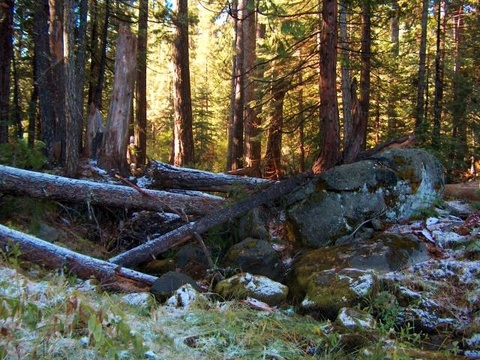 Snow is common in the winter in the areas where yellow pine forest is found. Photo by queerbychoice. Yellow pine forest is the plant community native to areas of Yuba County above approximately 1,600 feet, including Brownsville, Camptonville, Challenge, Dobbins, Eagleville, Greenville, North Star, Oak Valley, Plumas National Forest, Sharon Valley, Strawberry Valley, Sugar Pine Peak, Tahoe National Forest, Weeds Point, and Woodleaf. It is defined by the fact that a plurality of trees in it are yellow pines.
Snow is common in the winter in the areas where yellow pine forest is found. Photo by queerbychoice. Yellow pine forest is the plant community native to areas of Yuba County above approximately 1,600 feet, including Brownsville, Camptonville, Challenge, Dobbins, Eagleville, Greenville, North Star, Oak Valley, Plumas National Forest, Sharon Valley, Strawberry Valley, Sugar Pine Peak, Tahoe National Forest, Weeds Point, and Woodleaf. It is defined by the fact that a plurality of trees in it are yellow pines.
In the photos of understory plants from yellow pine forest, notice the thick layer of pine needles usually visible on the ground. If you are trying to grow plants from Yellow Pine Forest in your garden, you should cover the ground in your garden with pine straw mulch or the detritus of other native conifers. This mulch helps prevent moisture from evaporating and fosters the growth of beneficial mycorrhiza.
Yellow pine forest manifests itself somewhat differently at different elevations. At the lower elevations within its range, where canyon live oaks, Oregon white oaks, and California black oaks are nearly as common as yellow pines, it is sometimes called montane hardwood-conifer forest. Douglas-firs, bigleaf maples, sticky whiteleaf manzanitas, blackfruit dogwoods, tanbark oaks, and California bay laurels are also common trees in montane hardwood-conifer forest. As elevation increases within the montane hardwood-conifer forest range, canyon live oaks, Oregon white oaks, and California bay laurels become less common. Common shrubs and vines in montane hardwood-conifer forest include Indian manzanitas, shining netvein barberries, Pacific mountain dogwoods, dwarf wood roses, upright snowberries, and poison oak.1
At higher elevations, yellow pines comprise not just a plurality but a majority of trees in the forest. This is sometimes called true yellow pine forest. Balsam firs, incense cedars, sugar pines, Douglas-firs, sticky whiteleaf manzanitas, tanbark oaks, bitter cherries, canyon live oaks, Oregon white oaks, and California black oaks grow in true yellow pine forest. Common shrubs and vines in true yellow pine forest include Indian manzanitas, Sierra mountain misery, Pacific mountain dogwoods, California coffeeberries, Sierra gooseberries, various California lilacs, and poison oak.2
The plants listed below are native to yellow pine forest in Yuba County.3
Trees
Conifers
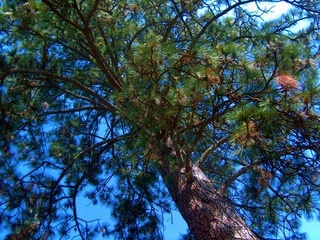 Yellow pine (Pinus ponderosa). Photo by queerbychoice. (See the Conifers pages for more information about these and other conifer species.)
Yellow pine (Pinus ponderosa). Photo by queerbychoice. (See the Conifers pages for more information about these and other conifer species.)
balsam fir (also called white fir or silver fir)
incense cedar (also called white cedar or post cedar)
yellow pine (also called bull pine, silver pine, ponderosa pine, or pitch pine)
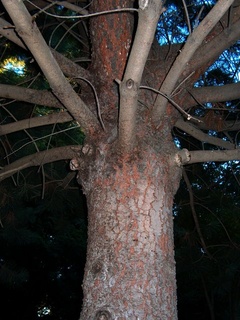 Sugar pine (Pinus lambertiana) in the California State University Sacramento arboretum. Photo by queerbychoice.
Sugar pine (Pinus lambertiana) in the California State University Sacramento arboretum. Photo by queerbychoice.
Broadleaf Trees
 Bigleaf maple (Acer macrophyllum) on the Feather River Little North Fork, north of Strawberry Valley. Photo by queerbychoice. (See the Native Edible Fruits and Oaks pages for more information about some of these species.)
Bigleaf maple (Acer macrophyllum) on the Feather River Little North Fork, north of Strawberry Valley. Photo by queerbychoice. (See the Native Edible Fruits and Oaks pages for more information about some of these species.)
blackfruit dogwood (also called miners' dogwood or Western cornelian cherry)
tanbark oak (also called tanoak)
Klamath plum (also called Sierra plum)
canyon live oak (also called gold cup oak or maul oak)
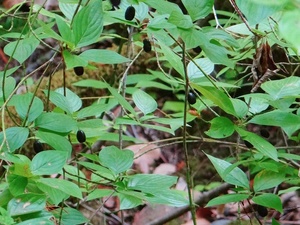 Blackfruit dogwood (Cornus sessilis) with fruit, growing alongside Frey Creek on the Feather Falls trail. Photo by queerbychoice.
Blackfruit dogwood (Cornus sessilis) with fruit, growing alongside Frey Creek on the Feather Falls trail. Photo by queerbychoice.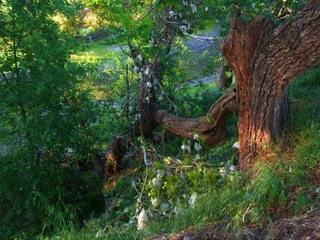 Frémont's cottonwood (Populus fremontii) in the American River Parkway, with cotton-like seeds. The tree is named for John C. Frémont. Photo by queerbychoice.
Frémont's cottonwood (Populus fremontii) in the American River Parkway, with cotton-like seeds. The tree is named for John C. Frémont. Photo by queerbychoice. 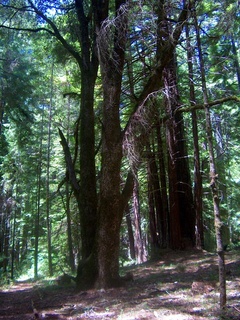 Canyon live oak (Quercus chrysolepis). Photo by queerbychoice.
Canyon live oak (Quercus chrysolepis). Photo by queerbychoice. 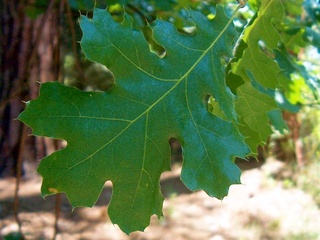 California black oak (Quercus kelloggii) can be identified by the bristles on the tips of its leaves. Photo by queerbychoice.
California black oak (Quercus kelloggii) can be identified by the bristles on the tips of its leaves. Photo by queerbychoice. 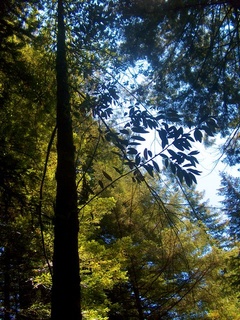 California bay laurel (Umbellularia californica). Photo by queerbychoice.
California bay laurel (Umbellularia californica). Photo by queerbychoice.
Shrubs
Buckthorn Family
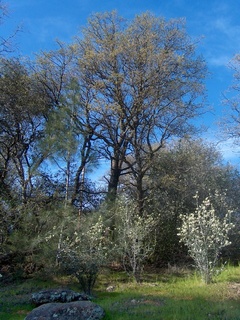 Several buckbrush (Ceanothus cuneatus) shrubs bloom with white flowers under oak and pine trees near Smartsville. Photo by queerbychoice. (See the California Lilacs and Buckthorns pages for more information about these and other California lilac and buckthorn species.)
Several buckbrush (Ceanothus cuneatus) shrubs bloom with white flowers under oak and pine trees near Smartsville. Photo by queerbychoice. (See the California Lilacs and Buckthorns pages for more information about these and other California lilac and buckthorn species.)
mountain whitethorn (also called snow bush)
buckbrush (also called wedgeleaf California lilac)
Mahala mat (also called pinemat)
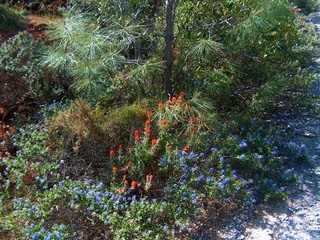 Lemmon's California lilac (Ceanothus lemmonii) blooming with blue flowers, accompanied by red paintbrushes and a young yellow pine tree. Photo by queerbychoice.
Lemmon's California lilac (Ceanothus lemmonii) blooming with blue flowers, accompanied by red paintbrushes and a young yellow pine tree. Photo by queerbychoice. 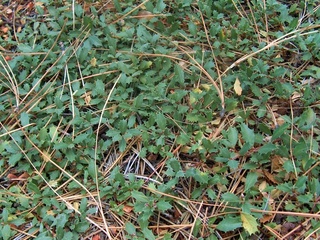 Mahala mat (Ceanothus prostratus). Photo by queerbychoice.
Mahala mat (Ceanothus prostratus). Photo by queerbychoice. 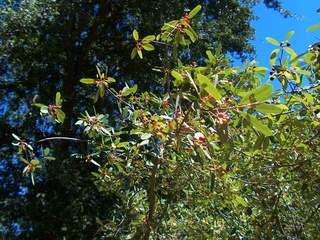 A California coffeeberry (Frangula californica) in the American River Parkway, laden with fruit. Photo by queerbychoice.
A California coffeeberry (Frangula californica) in the American River Parkway, laden with fruit. Photo by queerbychoice.
Rose Family
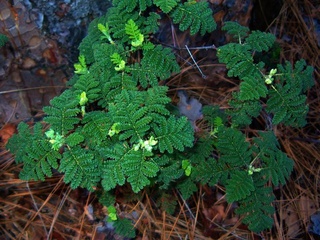 Sierra mountain misery (Chamaebatia foliolosa) near Grass Valley. Photo by queerbychoice. (See the Native Edible Fruits and Roses pages for more information about some of these species.)
Sierra mountain misery (Chamaebatia foliolosa) near Grass Valley. Photo by queerbychoice. (See the Native Edible Fruits and Roses pages for more information about some of these species.)
Sierra mountain misery (also called bearclover)
ocean spray (also called cream bush)
rock spiraea (also called small-leaf cream bush or ocean spray)
dwarf wood rose (also called baldhip rose)
Western raspberry (also called whitebark raspberry)
 Ocean spray (Holodiscus discolor). Photo by queerbychoice.
Ocean spray (Holodiscus discolor). Photo by queerbychoice. 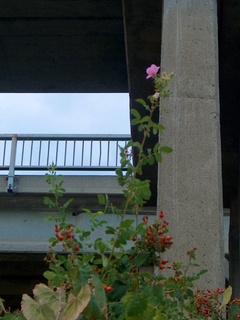 California wild rose (Rosa californica) under the 5th Street Bridge, with hips and one remaining flower in October. Photo by queerbychoice.
California wild rose (Rosa californica) under the 5th Street Bridge, with hips and one remaining flower in October. Photo by queerbychoice. 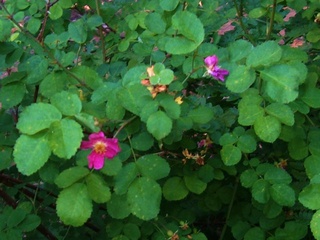 Dwarf wood rose (Rosa gymnocarpa) near Quincy. Photo by queerbychoice.
Dwarf wood rose (Rosa gymnocarpa) near Quincy. Photo by queerbychoice.
Other Plant Families
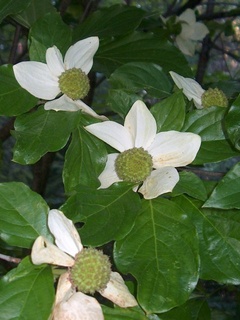 Pacific mountain dogwood (Cornus nuttallii) near Quincy. Photo by queerbychoice. (See the Beardtongues, Buckwheats, Native Edible Fruits, and Lupines pages for more information about some of these species.)
Pacific mountain dogwood (Cornus nuttallii) near Quincy. Photo by queerbychoice. (See the Beardtongues, Buckwheats, Native Edible Fruits, and Lupines pages for more information about some of these species.)
stickyleaf rabbitbrush (also called yellow rabbitbrush)
spicebush (also called sweet shrub)
yerba santa (also called mountain balm)
Oregon spicy wintergreen (also called Western wintergreen or Western teaberry)
Fremont's silk tassel (also called bearbrush)
silver bush lupine (also called evergreen purple lupine)
Sierra sweet bay (also called Sierra bayberry or mountain wax myrtle)
Oregon boxwood (also called Oregon boxleaf)
spreading snowberry (also called creeping snowberry or sharpleaf snowberry)
trailing snowberry (also called creeping snowberry)
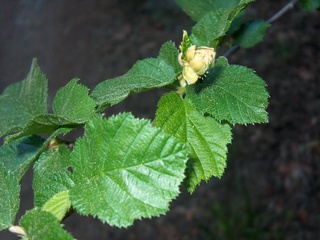 California hazelnut (Corylus cornuta) near Strawberry Valley. Photo by queerbychoice.
California hazelnut (Corylus cornuta) near Strawberry Valley. Photo by queerbychoice. 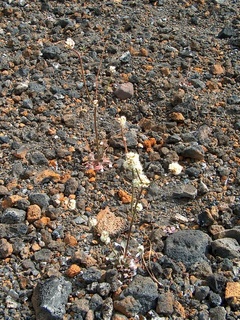 Naked buckwheat (Eriogonum nudum) is named for the fact that it has no leaves except for a few small ones at ground level. Photo by queerbychoice.
Naked buckwheat (Eriogonum nudum) is named for the fact that it has no leaves except for a few small ones at ground level. Photo by queerbychoice. 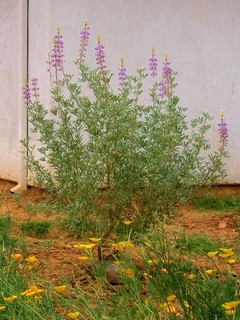 Silver bush lupine (Lupinus albifrons) in a garden in Marysville, with California golden poppies. Photo by queerbychoice.
Silver bush lupine (Lupinus albifrons) in a garden in Marysville, with California golden poppies. Photo by queerbychoice. 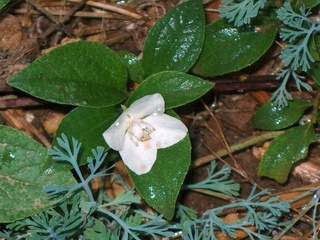 A single flower blooms on a ground-level branch of a young mock orange (Philadelphus lewisii) in a Marysville garden. Photo by queerbychoice.
A single flower blooms on a ground-level branch of a young mock orange (Philadelphus lewisii) in a Marysville garden. Photo by queerbychoice. 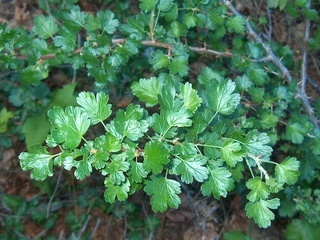 Sierra gooseberry (Ribes roezlii) near Strawberry Valley. Photo by queerbychoice.
Sierra gooseberry (Ribes roezlii) near Strawberry Valley. Photo by queerbychoice.
Vines
 Chaparral clematis (Clematis lasiantha) seedheads intertwine with toyon and poison oak. Photo by queerbychoice. (See the Native Edible Fruits page for more information about some of these species.)
Chaparral clematis (Clematis lasiantha) seedheads intertwine with toyon and poison oak. Photo by queerbychoice. (See the Native Edible Fruits page for more information about some of these species.)
chaparral clematis (also called pipestem clematis)
virgin's bower (also called Western creek clematis or yerba de chiva)
Pacific blackberry (also called trailing blackberry)
Herbaceous Perennials
Monocots
Grasses and Grasslike Plants
True Grasses
 Deergrass (Muhlenbergia rigens) in the California State University Sacramento arboretum. Photo by queerbychoice. (See the Ryegrasses and Oniongrasses pages for more information about some of these species.)
Deergrass (Muhlenbergia rigens) in the California State University Sacramento arboretum. Photo by queerbychoice. (See the Ryegrasses and Oniongrasses pages for more information about some of these species.)
Lemmon's needlegrass (also called Lemmon's stipa)
Letterman's needlegrass (also called Letterman's stipa)
Western needlegrass (also called Western stipa)
Stillman's needlegrass (also called Stillman's stipa)
squirreltail ryegrass (also called bottlebrush rye grass)
California wheatgrass (also called California wild rye grass)
nodding fescue (also called bearded fescue)
creeping wild rye (also called valley wild rye, alkali rye, or beardless wild rye)
smallflower oniongrass (also called coast range melic)
nodding needlegrass (also called nodding tussockgrass or nodding stipa)
purple needlegrass (also called purple tussockgrass or purple stipa)
pine bluegrass (also called one-sided blue grass)
Sedges
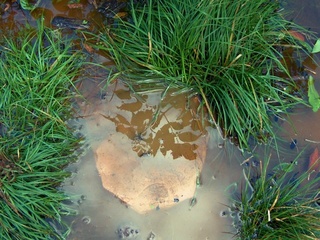 Clustered field sedge (Carex praegracilis) surrounds a submerged stepping-stone in a seasonally flooded garden in Marysville. Clustered field sedge grows very well in heavy clay soils that tend to be very dry in the summer but very wet in the winter. Photo by queerbychoice. (See the Sedges page for more information about these and other sedge species.)
Clustered field sedge (Carex praegracilis) surrounds a submerged stepping-stone in a seasonally flooded garden in Marysville. Clustered field sedge grows very well in heavy clay soils that tend to be very dry in the summer but very wet in the winter. Photo by queerbychoice. (See the Sedges page for more information about these and other sedge species.)
widefruit sedge (also called narrowleaf sedge)
many-stem sedge (also called forest sedge)
torrent sedge (also called naked sedge)
sand spikerush (also called Montevideo spikerush)
Rushes
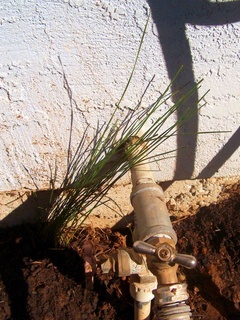 Wire rush (Juncus balticus) next to an outdoor faucet in Marysville. Photo by queerbychoice. (See the Rushes page for more information about these and other rush species.)
Wire rush (Juncus balticus) next to an outdoor faucet in Marysville. Photo by queerbychoice. (See the Rushes page for more information about these and other rush species.)
wire rush (also called Baltic rush)
dubius rush (also called Mariposa rush)
common bog rush (also called soft rush)
three-stamen rush (also called threestem rush or swordleaf rush)
poverty rush (also called slender rush)
Bulbs and Corms
Lily Family
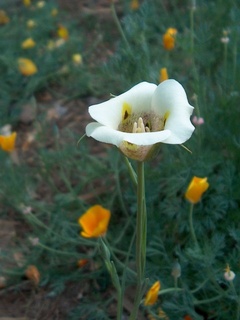 Superb mariposa tulip (Calochortus superbus) in a garden in Marysville, with California golden poppies. Photo by queerbychoice. (See the Tulips and Fritillaries pages for more information about some of these species.)
Superb mariposa tulip (Calochortus superbus) in a garden in Marysville, with California golden poppies. Photo by queerbychoice. (See the Tulips and Fritillaries pages for more information about some of these species.)
fairy lantern (also called white globe lily)
Sierra fawn lily (also called adder's-tongue)
mission bells (also called checker lily)
Orchid Family
spotted coralroot (also called summer coralroot)
Western ladies' tresses (also called creamy ladies' tresses)
Other Bulbs and Corms
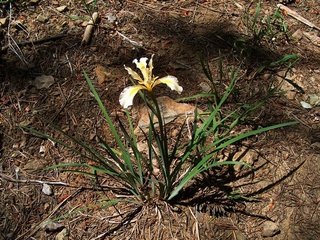 Rainbow iris (Iris hartwegii) near Strawberry Valley. Photo by queerbychoice. (See the Cluster-Lilies and Onions pages for more information about some of these species.)
Rainbow iris (Iris hartwegii) near Strawberry Valley. Photo by queerbychoice. (See the Cluster-Lilies and Onions pages for more information about some of these species.)
harvest cluster-lily (also called elegant cluster-lily)
blue dicks (also called wild hyacinth)
wild hyacinth (also called roundtooth snakelily or many-flowered cluster-lily)
wavyleaf soaproot (also called amole)
bowltube iris (also called longtube iris or ground iris)
slender iris (also called longtube iris)
feathery false lily of the valley
large false Solomon's seal (also called, Western false Solomon's seal, fat Solomon, or branched Solomon's seal)
meadow death camas (also called meadow zigadene)
Dicots
Aster Family
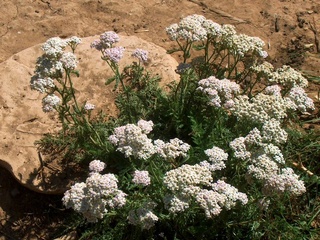 Yarrow (Achillea millefolium) in a garden in Marysville. Photo by queerbychoice. (See the Daisies and Mule Ears pages for more information about some of these species.)
Yarrow (Achillea millefolium) in a garden in Marysville. Photo by queerbychoice. (See the Daisies and Mule Ears pages for more information about some of these species.)
woolly sunflower (also called Oregon sunshine)
narrowleaf mule ears (also called California compassplant)
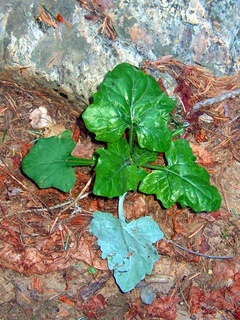 American trailplant (Adenocaulon bicolor) near Strawberry Valley, with one leaf overturned to show its much paler underside. It takes its common name from the fact that people walking through the woods often unknowingly turn over some of its arrow-shaped leaves with their feet, which provides an easy-to-spot way of following their trail. Photo by queerbychoice.
American trailplant (Adenocaulon bicolor) near Strawberry Valley, with one leaf overturned to show its much paler underside. It takes its common name from the fact that people walking through the woods often unknowingly turn over some of its arrow-shaped leaves with their feet, which provides an easy-to-spot way of following their trail. Photo by queerbychoice. 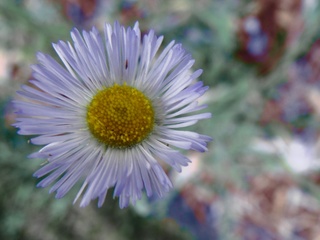 Diffuse daisy (Erigeron divergens) in a garden. Photo by queerbychoice.
Diffuse daisy (Erigeron divergens) in a garden. Photo by queerbychoice. 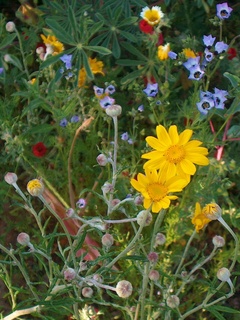 The yellow flowers and pinkish grey buds of woolly sunflower (Eriophyllum lanatum) mingle with tidytips, common goldfields, bird's eye gilyflower, and scarlet mallow in a Marysville garden. Photo by queerbychoice.
The yellow flowers and pinkish grey buds of woolly sunflower (Eriophyllum lanatum) mingle with tidytips, common goldfields, bird's eye gilyflower, and scarlet mallow in a Marysville garden. Photo by queerbychoice. 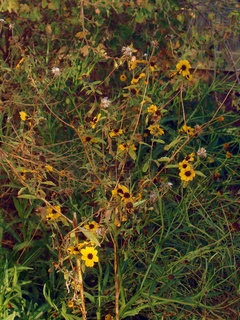 Serpentine sunflower (Helianthus bolanderi) blooms with the smaller flowers of rosillas (Helenium puberulum) in a Marysville garden. Photo by queerbychoice.
Serpentine sunflower (Helianthus bolanderi) blooms with the smaller flowers of rosillas (Helenium puberulum) in a Marysville garden. Photo by queerbychoice.
Heath Family
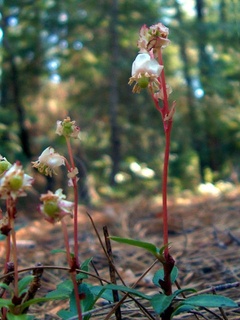 Little prince's pine (Chimaphila menziesii) near Quincy. Photo by queerbychoice. candystriped sugar stick little prince's pine (also called pipsissewa) Blake's prince's pine (also called pipsissewa) liverleaf wintergreen (also called bog wintergreen) whitevein wintergreen (also called whitevein shinleaf)
Little prince's pine (Chimaphila menziesii) near Quincy. Photo by queerbychoice. candystriped sugar stick little prince's pine (also called pipsissewa) Blake's prince's pine (also called pipsissewa) liverleaf wintergreen (also called bog wintergreen) whitevein wintergreen (also called whitevein shinleaf)
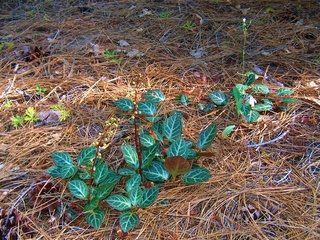 Whitevein wintergreen (Pyrola picta) near Quincy. Photo by queerbychoice.
Whitevein wintergreen (Pyrola picta) near Quincy. Photo by queerbychoice.
Pea Family
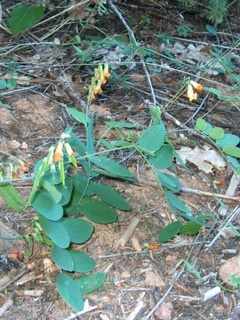 Sulphur pea (Lathyrus sulphureus) near Quincy. Photo by queerbychoice. (See the Deervetches, Lupines, and Clovers pages for more information about some of these species.)
Sulphur pea (Lathyrus sulphureus) near Quincy. Photo by queerbychoice. (See the Deervetches, Lupines, and Clovers pages for more information about some of these species.)
sulphur pea (also called snub pea)
chaparral bird's foot trefoil (also called bigleaf deervetch)
sicklekeel lupine (also called whitestem lupine)
dwarf tidy lupine (also called stool lupine]
Mint Family
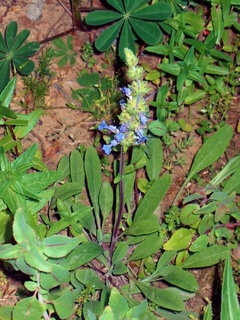 Creeping sage (Salvia sonomensis) in a garden in Marysville. Photo by queerbychoice. (See the Skullcaps page for more information about some of these species.)
Creeping sage (Salvia sonomensis) in a garden in Marysville. Photo by queerbychoice. (See the Skullcaps page for more information about some of these species.)
Sierra mint (also called mountain mint or California mint)
curve-flower skullcap (also called grayleaf skullcap)
Buttercup Family
 Western columbine (Aquilegia formosa) at Bowman Lake in Nevada County. Photo by queerbychoice. (See the Larkspurs and Buttercups pages for more information about some of these species.)
Western columbine (Aquilegia formosa) at Bowman Lake in Nevada County. Photo by queerbychoice. (See the Larkspurs and Buttercups pages for more information about some of these species.)
blue windflower (also called Western wood anemone)
Western columbine (also called crimson columbine)
pine forest larkspur (also called meadow larkspur)
spreading larkspur (also called zigzag larkspur)
smooth buttercup (also called sagebrush buttercup)
Rose Family
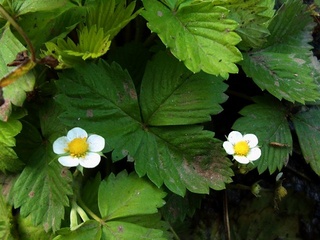 Woodland strawberry (Fragaria vesca) in a garden in Marysville. Photo by queerbychoice. (See the Native Edible Fruits pages for more information about some of these species.)
Woodland strawberry (Fragaria vesca) in a garden in Marysville. Photo by queerbychoice. (See the Native Edible Fruits pages for more information about some of these species.)
sticky cinquefoil (also called glandular five-finger)
Other Plant Families
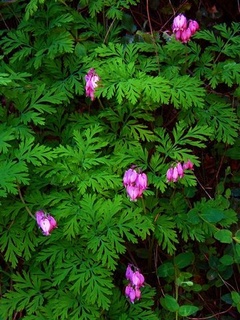 Pacific bleeding heart (Dicentra formosa) near Grass Valley. Photo by queerbychoice. (See the Milkweeds, Paintbrushes, Willowherbs, Woodland Stars, Beardtongues, and Violets pages for more information about some of these species.)
Pacific bleeding heart (Dicentra formosa) near Grass Valley. Photo by queerbychoice. (See the Milkweeds, Paintbrushes, Willowherbs, Woodland Stars, Beardtongues, and Violets pages for more information about some of these species.)
heartleaf milkweed (also called purple milkweed)
kotolo milkweed (also called Indian milkweed or woollypod milkweed)
rock toothwort (also called serpentine bittercress)
wavyleaf paintbrush (also called pine paintbrush)
broadleaf shooting star (also called mosquito bills)
California fuchsia (also called hummingbird trumpet)
Fringed Northern willowherb (also called slender willowherb)
round-headed buckwheat (also called rock buckwheat)
Siskiyou Mountain woodland star
California stoneseed (also called Shasta puccoon or California gromwell)
sagebrush bluebells (also called oblongleaf bluebells)
foothill beardtongue (also called bunchleaf beardtongue)
gay beardtongue (also called mountain blue beardtongue)
rock phacelia (also called Kaweah River phacelia)
checker mallow (also called wild hollyhock or dwarf checkerbloom)
Bridges' catchfly (also called Bridges' campion)
Western woodland star (also called Western star flower)
canary violet (also called Astoria violet)
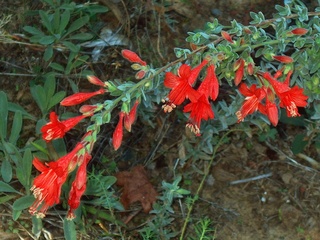 California fuchsia (Epilobium canum) blooms in a garden in Marysville. Photo by queerbychoice.
California fuchsia (Epilobium canum) blooms in a garden in Marysville. Photo by queerbychoice.
Ferns
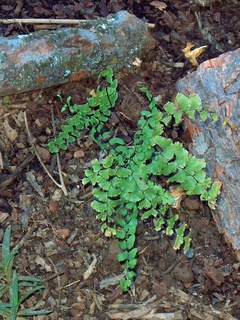 Five-finger fern (Adiantum aleuticum) in a Marysville garden. Photo by queerbychoice. (See the Maidenhair Ferns, Wood Ferns, and Horsetails pages for more information about some of these species.)
Five-finger fern (Adiantum aleuticum) in a Marysville garden. Photo by queerbychoice. (See the Maidenhair Ferns, Wood Ferns, and Horsetails pages for more information about some of these species.)
brittle bladderfern (also called fragile fern)
coffee fern (also called coffee cliffbrake)
bird's foot fern (also called bird's foot cliffbrake)
 Goldenback fern (Pentagramma triangularis) prefers full shade, as most ferns do. Photo by queerbychoice.
Goldenback fern (Pentagramma triangularis) prefers full shade, as most ferns do. Photo by queerbychoice.
Annuals
Monocots
Grasses
Dicots
Aster Family
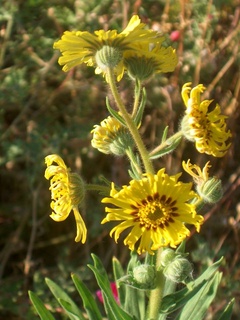 Common tarweed (Madia elegans) in a garden in Marysville. Photo by queerbychoice. (See the Daisies and Tarweeds pages for more information about some of these species.)
Common tarweed (Madia elegans) in a garden in Marysville. Photo by queerbychoice. (See the Daisies and Tarweeds pages for more information about some of these species.)
slender cottonweed (also called cotton top or Q-tips)
tall rod wirelettuce (also called twiggy wreath plant)
Pea Family
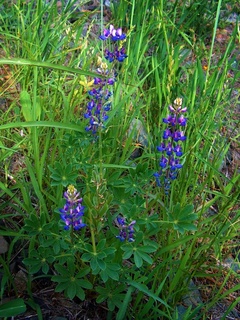 Arroyo lupine (Lupinus succulentus) on a levee in Marysville. Photo by queerbychoice. (See the Deervetches, Lupines, and Clovers pages for more information about some of these species.)
Arroyo lupine (Lupinus succulentus) on a levee in Marysville. Photo by queerbychoice. (See the Deervetches, Lupines, and Clovers pages for more information about some of these species.)
foothill shortpod deervetch (also called colchita)
arroyo lupine (also called hollowstem lupine or succulent lupine)
sour clover (also called bull clover)
hairy maiden clover (also called smallhead field clover)
minitomcat clover (also called fewflower clover)
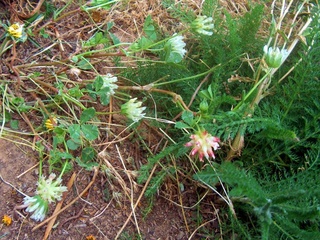 Sour clover (Trifolium fucatum) blooms in a garden in Marysville. Photo by queerbychoice.
Sour clover (Trifolium fucatum) blooms in a garden in Marysville. Photo by queerbychoice. 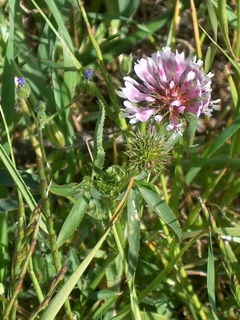 Tomcat clover (Trifolium willdenovii) in flower and bud on Table Mountain. Photo by queerbychoice.
Tomcat clover (Trifolium willdenovii) in flower and bud on Table Mountain. Photo by queerbychoice.
Evening-Primrose Family
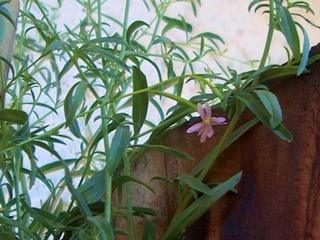 Tall autumn willowherb (Epilobium brachycarpum) blooms next to a six-foot-tall fence in Marysville. Photo by queerbychoice. (See the Clarkias and Willowherbs pages for more information about some of these species.)
Tall autumn willowherb (Epilobium brachycarpum) blooms next to a six-foot-tall fence in Marysville. Photo by queerbychoice. (See the Clarkias and Willowherbs pages for more information about some of these species.)
farewell-to-spring (also called slender clarkia or graceful clarkia)
winecup clarkia (also called purple clarkia)
denseflower willowherb (also called denseflower spike-primrose)
little chaparral willowherb (also called desert willowherb)
Broomrape Family
(See the Paintbrushes page for more information about some of these species.)
cutleaf Indian paintbrush (also called foothill owl's clover)
sagebrush Indian paintbrush (also called thinlobe owl's clover)
Lopseed Family
(See the Monkeyflowers page for more information about these and other monkeyflower species.)
Phlox Family
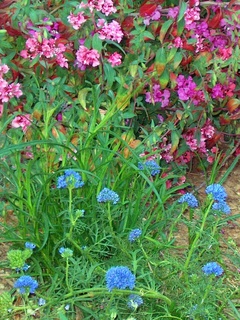 Globe gilyflower (Gilia capitata) and mountain garland in a garden in Marysville. Photo by queerbychoice.
Globe gilyflower (Gilia capitata) and mountain garland in a garden in Marysville. Photo by queerbychoice.
Other Plant Families
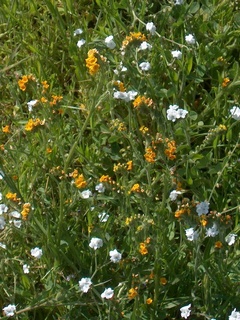 Smallflower fiddleneck (Amsinckia menziesii) and unidentified popcornflowers on Table Mountain. Photo by queerbychoice. common fiddleneck
Smallflower fiddleneck (Amsinckia menziesii) and unidentified popcornflowers on Table Mountain. Photo by queerbychoice. common fiddleneck
charming centaury (also called canchalagua or beautiful centaury)
thymeleaf sandmat (also called thymeleaf spurge)
chaparral dodder (also called California dodder)
common bluecup (also called Venus' looking glass)
common dwarf flax (also called smallflower Western flax or threadstem flax)
Douglas' stitchwort (also called Douglas' sandwort)
small baby blue eyes (also called canyon nemophila)
California scarlet campion (also called California Indian pink)
sand fringepod (also called hairy lacepod)
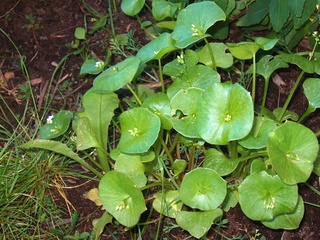 The tiny, pale pink flowers of miner's lettuce (Claytonia perfoliata) bloom in a garden in Marysville. This plant is prized as a salad ingredient, generally sold only at high-end grocery stores. Growing your own is much cheaper than buying it from a grocery store! Photo by queerbychoice.
The tiny, pale pink flowers of miner's lettuce (Claytonia perfoliata) bloom in a garden in Marysville. This plant is prized as a salad ingredient, generally sold only at high-end grocery stores. Growing your own is much cheaper than buying it from a grocery store! Photo by queerbychoice. 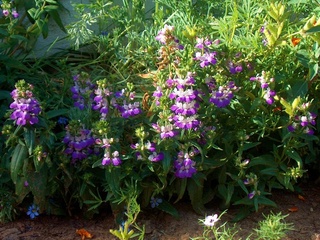 Purple Chinese pagodas (Collinsia heterophylla) in a garden in Marysville. Photo by queerbychoice.
Purple Chinese pagodas (Collinsia heterophylla) in a garden in Marysville. Photo by queerbychoice. 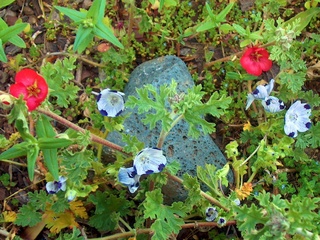 Five spot (Nemophila maculata) blooms in a garden in Marysville, along with non-native scarlet mallow. Photo by queerbychoice.
Five spot (Nemophila maculata) blooms in a garden in Marysville, along with non-native scarlet mallow. Photo by queerbychoice. 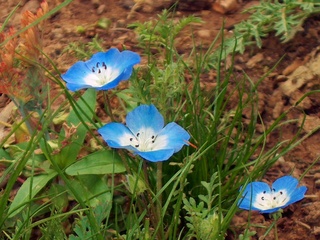 Baby blue eyes (Nemophila menziesii) bloom in a garden in Marysville. Photo by queerbychoice.
Baby blue eyes (Nemophila menziesii) bloom in a garden in Marysville. Photo by queerbychoice.
Footnotes
1. California Department of Fish and Game: Wildlife Habitats—California Wildlife Habitat Relationships System
2. California Department of Fish and Game: Wildlife Habitats—California Wildlife Habitat Relationships System
3. CalFlora.org


